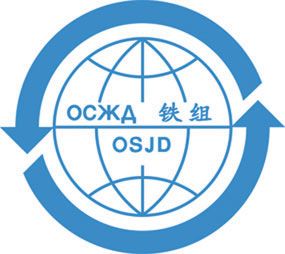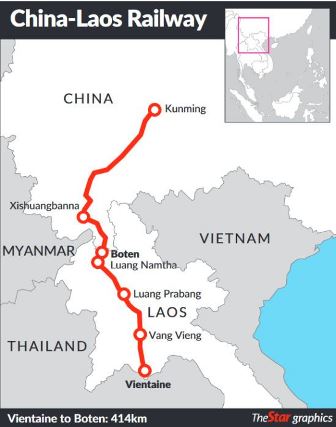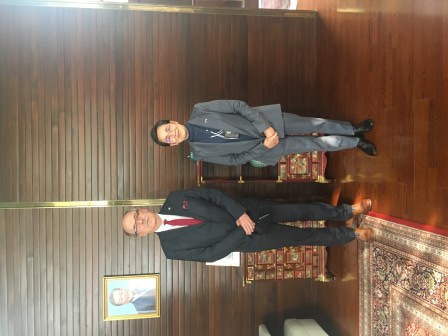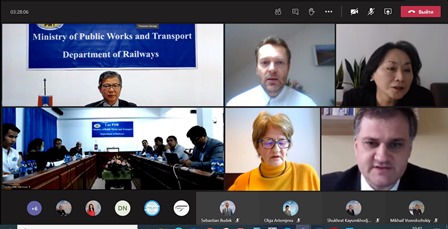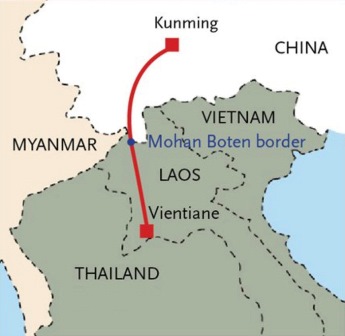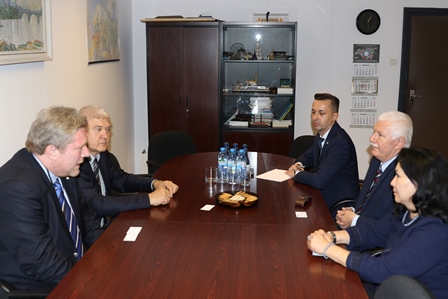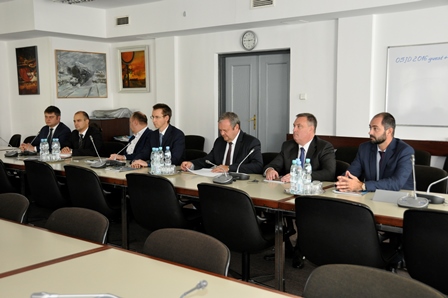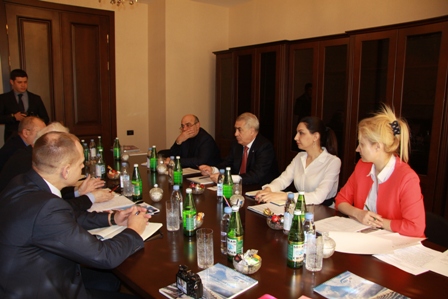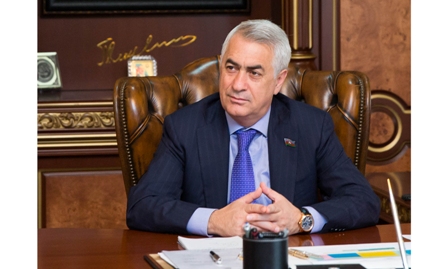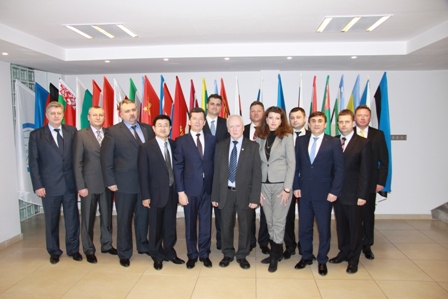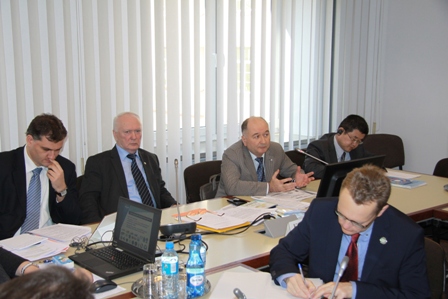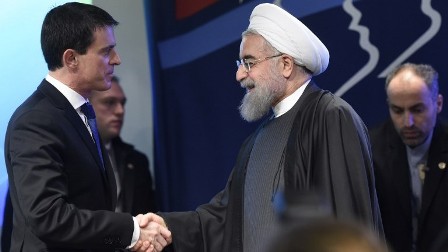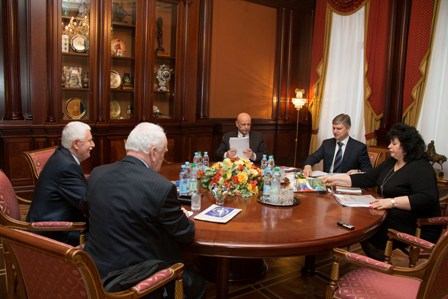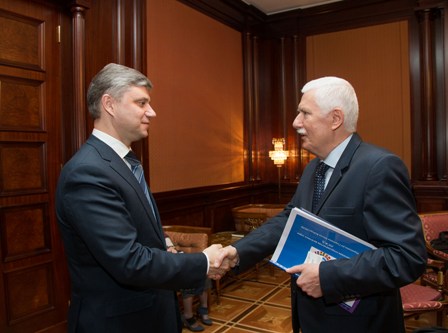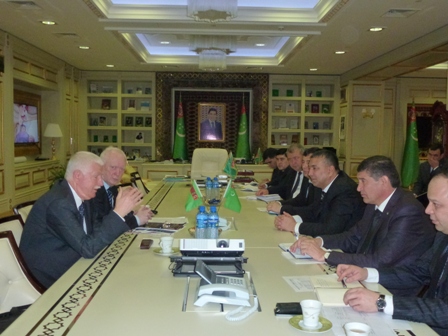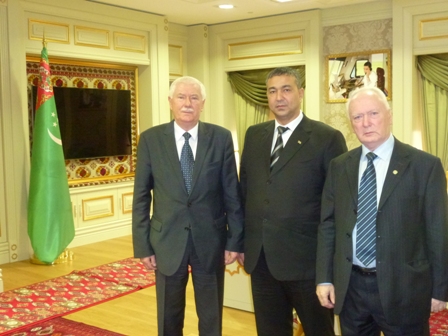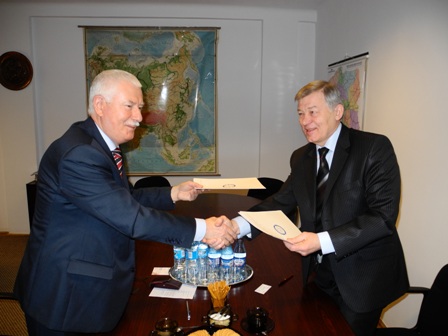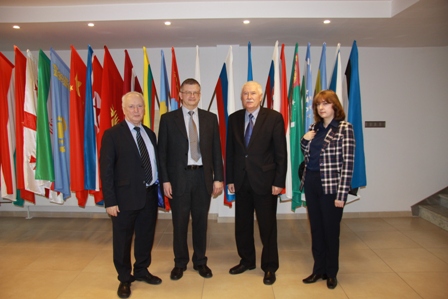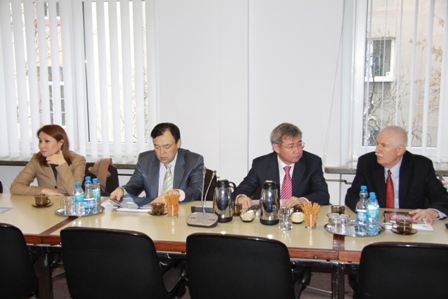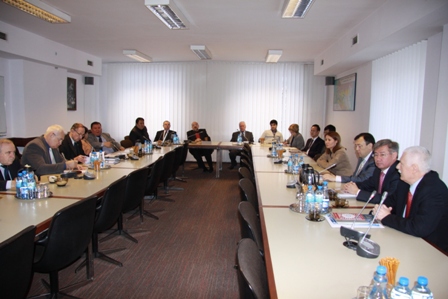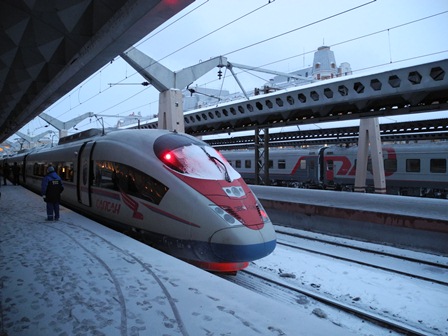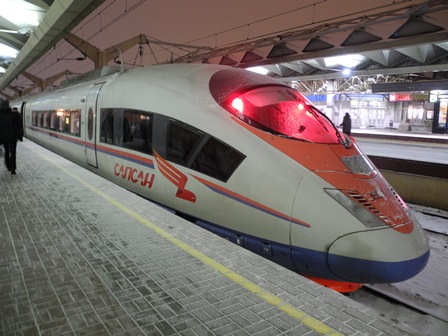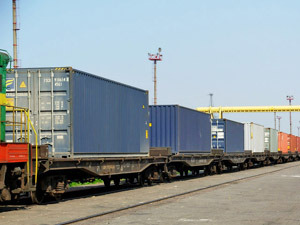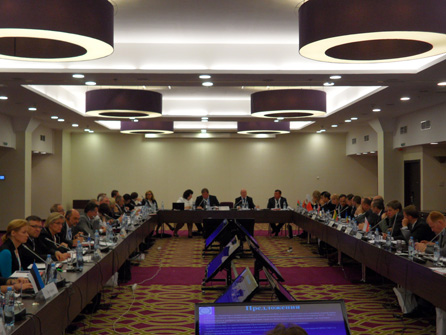Cooperation
The delegation from the Republic of Korea visited the OSJD Committee and took part in the Korean-Polish Forum for Cooperation in the Field of High-Speed Rail Technologies in Warsaw
On 27 April 2022, the OSJD Committee hosted a delegation from the Republic of Korea which came on a working visit and was represented by the officials from the Department for Railway Transport Policy of the Ministry of Land, Infrastructure and Transport – Deputy Director of the Department O Jimin and Assistant Director of the Department Park Hana, as well as employees of the Korean National Railway (KNR).
The delegation of the OSJD Committee headed by the Deputy Chairman Mr. Zhang Qun and the guests from the Republic of Korea exchanged their views on the current issues of mutual cooperation.
On 28 April 2022, the guests attended the Korean-Polish High-Speed Railway Technology Cooperation Forum organised by the Korean National Railway (KNR) and Dohwa Engineering Co. Ltd.
From the Polish side, the forum was attended by specialists and experts in the field of railway infrastructure from the state bodies and PKP JSC. The delegation of the Republic of Korea was represented by the officials from the Ministry of Land, Infrastructure and Transport of the Republic of Korea, Ambassador Extraordinary and Plenipotentiary of the Republic of Korea to the Republic of Poland Hoonmin Lim, specialists from the KNR and Dohwa Engineering Co. The OSJD Committee was represented by Deputy Chairman Zhang Qun, specialist of the OSJD Commission on Passenger Traffic – representative of the Republic of Korea at the OSJD Committee Kang Hyeonsoo and specialist of the OSJD Commission on Infrastructure and Rolling Stock – representative of the Republic of Azerbaijan at the OSJD Committee Angelina Shurganova.
The specialists from KNR and Dohwa Engineering provided an overview of the construction and operation processes on high-speed railway lines.
The Korean National Railway (KNR) is a stateowned railway company responsible for planning, designing, construction management, testing and supervision of railway infrastructure and high-speed railway lines (HSR). The countdown to high-speed traffic in the Republic of Korea began in 2004, when the country's first high-speed railway line was built on the Gyeongbu line. At present, there are about 1800 km of high-speed railway lines operating in the country. The trains develop speeds of more than 300 km/h on the route, therefore, at such speeds, the technologies for building a railway track and laying rails, as well as signaling and communication systems, are of particular importance – and that is what the forum participants were provided with detailed information, including the technology of two-stage and three-stage control and safety mechanisms for train traffic, which maintain a certain speed and ensure trouble-free operation of the trains.
Dohwa Engineering, in turn, is a Korean leader in the field of railway engineering and has many industry achievements. Dohwa Engineering has access to the best technologies and know-how in the design and supervision of the construction of conventional railways, high speed lines and railway depots. Currently, the company is working on projects in 20 countries worldwide and successfully invests in the construction of the GTX-A railway line in the Republic of Korea with a maximum speed of 200 km/h, acting as a direct investor and project management consultant.
Infrastructural development in Poland has been of considerable interest to Korean specialists for a long time. In December 2021, representatives of the Republic of Poland and the Republic of Korea signed an agreement on the establishment of a joint venture, in which the Korean side should receive a minority stake in the Central Communications Port (Centralny Port Komunikacyjny - CPK).
The construction of the CPK was supported even earlier, in the beginning of 2021, by the Incheon International Airport Corporation (IIAC). As part of the implementation of ambitious investment projects, it is planned to build a network of high-speed railway lines with a length of up to 1800 km, which naturally arouses great interest among foreign investors.
The meeting was held in a friendly atmosphere and created a unique opportunity for the exchange of information and technologies between Polish and South Korean specialists.
It is expected that in the future the cooperation forum in the field of high-speed railway technologies will be held on a regular basis, and Korean specialists will organise training for Polish engineers. Other initiatives are planned to develop railway technology in Poland, as well.
Laos has expressed its intention to become a member of OSJD (press-release)
In accordance with the decision of the Government of the Lao People’s Democratic Republic, adopted on 24 March 2022, the Ministry of Public Works and Transport of the Lao People’s Democratic Republic, which is in charge of the Lao Railways, sent a letter to the OSJD Committee with an official request to admit the LPDR to the Organisation of Co-Operation between Railways. The letter was signed by the Minister of Public Works and Transport of the Lao PDR, Mr. Viengsavath Siphandone.
In this letter, the Ministry of Public Works and Transport also expressed its intention to become a Party to the Agreement on International Passenger Traffic (SMPS) and the Agreement on International Freight Traffic by Rail (SMGS) to ensure the smooth transport of passengers and goods in the international railway traffic.
In accordance with the OSJD procedures, the issue of joining the Lao PDR will be considered by the governing bodies of OSJD, and the final decision on this issue is to be taken within the framework of the OSJD Ministerial Conference session.
As a preliminary step, the issues related to the entry of the Lao PDR into OSJD were considered a year ago during a consultation meeting of the delegations of the OSJD Committee and the Lao PDR (with the participation of the UNESCAP representatives), which took place on 10 February 2021 using the videoconferencing mode. At the meeting, the Lao side, headed by Mr. Viengsavath Siphandone, confirmed their interest in joining OSJD at the stage the construction of the railway line from China, scheduled for the end of 2021, was completed. The Chairman of the OSJD Committee, Mr. Mirosław Antonowicz, who headed the OSJD delegation, expressed his full support for the entry of Laos into OSJD. Also, in order to clarify the goals and objectives of OSJD, the role of the SMPS and SMGS Agreements, on 26 May 2021, the OSJD-UNESCAP Joint Seminar for the representatives of the Lao People’s Democratic Republic was organised in a videoconferencing mode, as well as a regular exchange of letters was maintained in order to facilitate the entry of the Lao PDR into OSJD.
The completion of the China-Laos railway line construction and its commissioning on 3 December 2021 have made it possible to implement the plans outlined by the Government of the Lao PDR for further railway transport development, including that in the international traffic. In this regard, cooperation within the OSJD framework can become an important incentive and tool for expanding and intensifying the railway traffic along one of the longest routes in the world – OSJD corridor No. 1, which will provide a sustainable connection of Laos, Thailand, Singapore and other countries of the Indochinese Peninsula with the railway network of China and other countries of the Eurasian continent, ensuring an unimpeded movement of passengers and goods both in the countries of the South-East Asia region and from these countries to Asia and Europe along the land route.
For reference
The Lao People’s Democratic Republic is situated in South-East Asia on the Indochinese Peninsula. It borders on Thailand, Vietnam, Cambodia, China and Myanmar. Laos is a landlocked country having no direct access to the sea, so the development of railways and international railway traffic are of paramount importance for it.
Nowadays, the overall operational length of the railway lines of Laos amounts to 425.94 km, of which:
- Vientiane-Boten Railway (with a track gauge of 1435 mm) – 422.44 km;
- Vientiane-Thanaleng Railway (with a track gauge of 1000 mm) – 3.5 km.
As it is clearly seen, the length of the railway section from the Boten border station on the China-Laos boundary to the capital of Laos, Vientiane, is about 422 km, while the total length of the Kunming (China) – Vientiane (Laos) railway line is 1035 km. The construction of the railway line was carried out on the basis of the Chinese technologies and engineer standards.
In total, 167 tunnels have been laid along the route of the line and a large number of bridges and viaducts built.
The railway is subdivided into two sections: Chinese and Laotian. The construction of the Laotian section from the border town of Boten to Vientiane began in December 2016, while the construction of the Chinese section from Yuxi to the border town of Mohan began in December 2015.
With a maximum operational speed of 160 km/h, the entire journey with border clearance procedures takes about 10 hours. This route provides for the transportation of both passengers and goods. The commissioning of the new line has made it possible to switch a significant part of export goods onto the railway and reduce the transportation costs.
According to the preliminary calculations, at the initial stage, 300,000 containers will be transported annually along the new railway line from Laos to Europe through China, and in the future, the freight flow may increase to 1.2-1.8 million containers per year.
Already in the first two and a half months since the start of the China-Laos railway operation, more than 1 million passengers and 500 thousand tons of goods have been transported on it, while 100 thousand tons of the total volume of transported goods have been carried in international traffic.
Delegation of the OSJD Committee met with Ambassador Extraordinary and Plenipotentiary of the Republic of Korea to the Republic of Poland
(press-release)
On 15 October 2021, a working meeting was held between the delegation of the OSJD Committee headed by the Chairman of the OSJD Committee Mirosław Antonowicz and the delegation of the Embassy of the Republic of Korea in the Republic of Poland, headed by HE Ambassador Extraordinary and Plenipotentiary Mira Sun.
Mirosław Antonowicz informed about the work being done within the OSJD framework and appreciated the active participation in them of the representatives of the Republic of Korea and their contribution to the development of railway transport in the region. HE Ambassador of the Republic of Korea thanked Mirosław Antonowicz for the active work and measures taken to ensure safe working conditions for the OSJD Committee employees in the context of the pandemic, as well as expressed her hope for the normalisation of the situation and the holding of the next session of the OSJD Ministerial Conference in 2023 in the Republic of Korea in accordance with the planned schedule and in a face-to-face format.
The parties also discussed the issues of a possible meeting of the OSJD Committee Chairman with the Minister of Land, Infrastructure and Transport of the Republic of Korea Mr. No Hyung-uk and participation in the 1st EARC International Forum were also considered. Earlier, on 14 January 2019, a similar meeting with the delegation of the Republic of Korea took place in the OSJD Committee premises, in which Mrs. Mira Sun also took part.
In conclusion, the parties noted the importance and effectiveness of continuing bilateral and multilateral contacts within the OSJD framework for the development of cooperation between the countries and railways in order to elaborate and take effective measures in the field of railway transport in the Eurasian space.
Consultative meeting on Lao People’s Democratic Republic joining the Organisation for Co-Operation between Railways
On 10 February 2020, a consultative meeting was held on Lao People’s Democratic Republic joining the Organisation for Co-Operation between Railways. The Lao PDR delegation was headed by Mr. Viengsavath Siphandone, Vice Minister, Ministry of Public Works and Transport, and Mr. Miroslaw Antonowicz, Chairman of the OSJD Committee, was head of the OSJD Committee delegation.
The virtual meeting was also attended by a UNESCAP delegation led by Mr. Weimin Ren, Director, UNESCAP Transport Division.
The meeting was opened by Chairman of the OSJD Committee Mr. Miroslaw Antonowicz. In his welcoming remarks to the delegates, he noted that 2021 was a milestone year for the OSJD as the Organization marked its 65th anniversary since foundation. In this context, the officially declared interest of Lao PDR in joining the OSJD provided clear evidence of the Organization’s relevance, and was indicative of strong prospects that other States of South-East Asia would join the area that relies on the OSJD transport law.
Miroslaw Antonowicz pointed out that finding and implementing strategic solutions that would foster further advance and development of railway traffic between Asia and Europe was the core mission of the OSJD. Consequently, the OSJD’s efforts to improve and update the legal and technical regulatory framework were of great importance. The range of OSJD activities includes: the text of the Convention on Direct International Railway Traffic; improvement and development of 13 OSJD railway transport corridors; development of container and multimodal transport operations; facilitation of border crossing through simplification of border crossing procedures and wider application of the unified CIM/SMGS consignment note; organisation and implementation of express delivery of postal items and mixed consignments by rail; introduction of digital technologies into the transport and logistics sectors; strengthening cooperation with international transport organisations such as UNESCAP, UNECE, EU, EAEU, OTIF, ERA, CIT, WCO, UPU, UIC, CCTT, and others.
The Chairman of the OSJD Committee emphasized that the OSJD welcomes new members to the Organisation to expand international collaboration in transport and improve the efficiency of the railway industry as a whole.
In his intervention, Mr. Weimin Ren, Director of the UNESCAP Transport Division, focused on the negative impact of the pandemic on all economic activities, including transport. In that context, the demand for freight transportation between Asia and Europe continued to grow, especially for carriage by container trains.
In such an environment, UNESCAP and OSJD continued their joint efforts to increase the traffic volumes between Europe and Asia. To this end, the Organisations continued to hold virtual joint meetings and adopted a Joint UNESCAP- OSJD Declaration on strengthening international railway transport operations on the Trans-Asian railway network and beyond in response to the pandemic.
Mr. Weimin Ren also emphasized that UNESCAP attached great importance to the development of railway transport in the region, since it represents the most environmentally friendly mode of transport that was capable of ensuring sustainable mobility. In his view, the OSJD played a key role in bringing together the railway systems of the two continents, which was also very important for Lao PDR as the Republic was energetically developing its railways, and would foster the country’s social and economic growth.
Mr. Viengsavath Siphandone, Vice-Minister, LPDR Ministry of Public Works and Transport, noted that the LPDR was seeking to take its proper place as an important link in the global logistics chain where transport plays a key role.
It was for this reason that LPDR had increasingly focused on the construction and development of railways, with the efforts to build the over 400-km-long railway line from China to Vientiane, the capital of LPDR, nearing completion.
In this context, LPDR’s joining the OSJD would strengthen the transport connectivity with China and other Eurasian nations of not only Laos, but also of other countries of the Indochina Peninsula.
During the meeting, the LPDR delegation was provided detailed information on all aspects of the OSJD’s activities.
In his presentation, Deputy Chairman of the OSJD Committee Mr. Mikhail Vsevolozhskiy provided an overview of the mission, objectives, structure and operation of the OSJD.
Mr. Shukhrat Kayumkhodjaev, Chairman of the OSJD Commission on Transport Policy and Development Strategy, shared information on the activities of the Commission, highlighting the efforts to further develop the OSJD railway transport corridors and facilitate border crossing.
The Specialist of the OSJD Commission on Transport Law Ms. Jelena Antonevich reviewed the role of the SMPS and SMGS Agreements in ensuring seamless railway traffic between Asia and Europe, and the efforts to improve and update these Agreements and their Annexes.
In her presentation, Ms. Zubaida Aspayeva, Chairperson of the OSJD Commission on Freight Traffic, gave an account of the significant work on updating the ETT and MTT Tariffs, PGW Agreement, Harmonized Nomenclature of Goods (GNG) and its synchronization with the NHM. She also dwelled on the development of container and combined transport operations between Asia and Europe, and on the organisation of block container trains that had been adding to the number of regular routes every year (in 2020, there was a total of 10,180 block container trains runs between Asia and Europe).
The introduction of electronic document processing systems and electronic consignment notes would further reduce the duration of a transport operation, thus giving railway transport a better competitive edge over maritime transport.
Mr. Radovan Vopalecky, Chairman of the OSJD Commission on Infrastructure and Rolling Stock, dwelt on the subject of technical leaflets developed by the Commission for the purpose of ensuring interoperable traffic on the railways with 1435-mm and 1520-mm track gauges that would need no reloading of goods or transfer of passengers. He informed also about the ongoing cooperation with the UIC on migrating joint OSJD/UIC Leaflets into draft International Railway Solutions.
Executive Secretary of the OSJD Committee Mr. Attila Kiss summarized the work of the Ad Hoc Working Group on Vocational Training/ Education in Railway Transport, and the efforts to set up and operate the OSJD Academy.
The LPDR delegation was also provided with detailed information on the procedure for joining the OSJD, as well as the SMPS and SMGS Agreements.
The LPDR delegation reconfirmed the country’s interest in joining the OSJD as the railway line to China was nearing completion. The line is scheduled for commissioning at the end of 2021.
The LPDR was also interested in joining the SMPS and SMGS Agreements. The railway line may become an extension of one of the OSJD’s longest corridors, Corridor No. 1, and link together LPDR, Thailand, Singapore, and other countries of the Indochina Peninsula, connecting them with the railway network of China and other countries of the Eurasian continent. This would enable a seamless land transportation of passengers and freight both between the countries of South-East Asia, and from those countries to the rest of Asia and to Europe.
Concluding the meeting, Chairman of the OSJD Committee Mr. Miroslaw Antonowicz thanked all the participants for the constructive discussions and reemphasized that the OSJD would welcome the Lao People’s Democratic Republic as a member to enhance cooperation in railway transport not only on the Indochina Peninsula or South-East Asia, but also in the entire OSJD area.
Cooperation in the development of international “South-West”
transport route
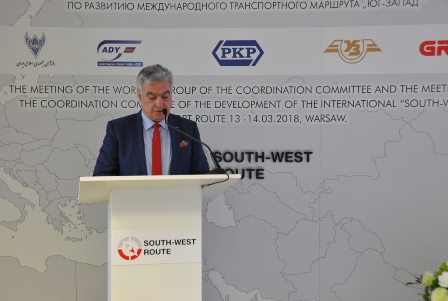
On 14 March 2018, the regular meeting of the Coordination Committee for the Development of the International “South-West” Transport Route was held in Warsaw - the capital of Poland.
The event was attended by specialists and heads of delegations from the railway administrations of Azerbaijan, Georgia, Iran, Poland and Ukraine.
Within the framework of the meeting, a number of issues were discussed and strategic important decisions were made. With the purpose to further develop the route and to attract additional freight flows, it was decided to apply until the end of 2018 comprehensive coordinated tariffs for the transportation of goods from India via the port of Mumbai through the territory of the Islamic Republic of Iran, Republic of Azerbaijan, Georgia and Ukraine and further via the Slawkow Terminal (Republic of Poland) to the countries of the European Union.
The Parties participating in the meeting confirmed their interest in organising and running the pilot container train (block train) on the route Slawkow (Poland) - Astara (Iran), as well as considered tariffs for the transportation of goods in wagons and containers for private rolling stock along the route South - West for 2018.
In connection with the commissioning of the Astara station in Iran, the tariff conditions for transportation in Azerbaijan and Iran were revised and approved by the Azerbaijani and Iranian sides. The Ukrainian and Georgian parties have achieved positive results in optimising tariff conditions on the sea section of the route (on the Black Sea).
They have also discussed the issues of concluding an agreement between the parties (Azerbaijan, Georgia, Iran and Poland) regarding the free transportation of empty containers and open wagons (no more than one block train in a month).
The Azerbaijani delegation informed the participants about the complex tariff rates which information was posted on the Website of the route.
At the end of the meeting, the ceremony of signing the minutes took place.
The parties noted that the issues discussed will facilitate the development of South-West route, increase its transit potential and attract additional freight traffic volumes.
Within the framework of the event presentations of railway administrations were delivered, in which the potentials, opportunities and plans for the development of transportation were demonstrated, as well as business meetings were held with potential customers and forwarding companies.
It’s worth recalling, that the international transport route “South - West” is designed for the transport of goods between the European Union and India. The delivery time of goods along alternative routes in this direction currently amounts to 35-37 days. The corridor South - West, which runs through Iran, Azerbaijan, Georgia and Ukraine, will significantly reduce the delivery time. The anticipated time of goods delivery on this route will amount to seven days.
Further Cooperation Development between OSJD and FIATA
(press-release)
Within the framework of the annual meeting of the OSJD Commission on Freight Traffic, which was held from 10 till 13 October 2017 in the OSJD Committee, a working meeting of OSJD Committee Chairman, Tadeusz Szozda with FIATA General Director, Hans Günther Kersten was organised on 11 October. The meeting was also attended by Chairperson of the OSJD Commission on Freight Traffic, Zubaida Aspayeva and Adviser of “PLASKE” JSC (OSJD affiliated enterprise) / Director General of the Port Community Association (Ukraine) Vasily Zubkov.
The parties discussed the issues of further cooperation development between the two organisations on the basis of a bilateral Memorandum on Cooperation signed on 6 October 2016 to increase rail and combined transport between Europe and Asia.
Chairman of OSJD Committee Tadeusz Szozda congratulated Hans Günther Kersten onthe start of his duties at the new important post and dwelt on the work carried out within the framework of OSJD, including the adoption of the text of the Convention on Direct International Railway Traffic, which includes the SMPS and SMGS Agreements as annexes. He stressed the importance of further cooperation in the field of container, combined and multimodal transport development between Europe and Asia, placing greater emphasis on the railway component. Tadeusz Szozda also invited FIATA to participate in the new field of OSJD activities – work on the issues of vocational training / education in the field of railway transport.
FIATA General Director, Hans Günther Kersten had been seconded by his previous employer - Deutsche Bahn (DB AG) to the UIC Secretariat as Freight Director before joining FIATA on June 1st, 2017 and assuming the function of General Director of FIATA on September 1st, 2017. Hans Günther Kersten is well aware of the status of the land freight traffic on the Eurasian continent and of the OSJD’s activities in the field of their development. He noted that FIATA with a total of 106 Association Members in 95 countries and about 5,900 Individual Members in 161 countries represented directly or indirectly about 40,000 logistics providers worldwide. Furthermore, FIATA has the potential to support OSJD activities in various areas by using its active Railway Working Group.
FIATA Association, the General Director further noted, also had extensive experience in the field of vocational training for the transport industry. Within the framework of FIATA an Advisory Body on Vocational Training as well as the FIATA Logistics Academy (FLA) had been established. Furthermore, there was also a FIATA Foundation on Vocational Training. PLASKE JSC, a member of FIATA, also has extensive experience in this field, which not only prepares specialists for the transport industry, but also trains instructors.
The parties suggested that both organisations take active mutual part in the events organized within the framework of them and include this activity into the work plans for the next year.
Signing of the Memorandum on Cooperation between OSJD and FIATA
(press-release)
On 6 October 2016 the capital of Ireland – the city of Dublin hosted the World Congress of the International Federation of Freight Forwarding Associations (FIATA) within the framework of which a Memorandum on Cooperation between the Organisation for Cooperation between Railways (OSJD) and the International Federation of Freight Forwarding Associations (FIATA) was signed.
The official signing ceremony was held within the session of the Multimodal Business Forum. From the OSJD Committee side the signing ceremony was attended by Mr. Attila Kiss, Secretary of OSJD Committee.
Addressing the Congress participants, Secretary of OSJD Committee drew attention to the progress in the OSJD activities towards the development of rail transport in the Euroasian region which has been reached within 60 years, and also expressed congratulations to FIATA in connection with its 90th anniversary.
On behalf of FIATA the Memorandum was signed by Mr. Huxiang Zhao, President of FIATA.
The Memorandum of Understanding between FIATA and OSJD will promote the cooperation development in the field of international freight traffic improvement between Europe and Asia.
Visit of the RZD JSC delegation
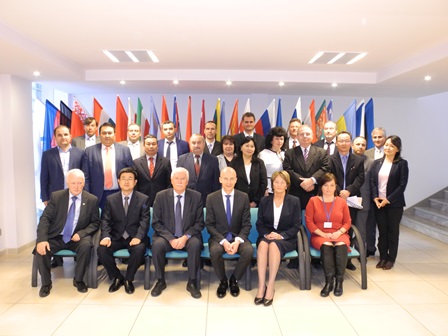
On 14 October 2016 a delegation of the Russian Railways JSC headed by Vyacheslav Pavlovsky, Vice-President of RZD JSC, paid a working visit to the OSJD Committee. From the OSJD Committee’s side the meeting was attended by Tadeusz Szozda, OSJD Committee Chairman, and Members of the Committee.
The parties informed each other on the work being carried-out at present and on the plans for the future.
It was noted that the Russian Railways JSC plays an important role in the OSJD activities, performing as a leading duty holder the large volume of works on various subjects.
The parties exchanged opinions on the most important aspects of the international railway traffic development and strengthening of cooperation within OSJD framework.
Visit of the FPC JSC delegation
On 15 September 2016 a delegation of the Federal Passenger Company JSC headed by Pyotr Ivanov, General Director of FPC, paid a working visit to the OSJD Committee. From the OSJD Committee’s side the meeting was attended by Tadeusz Szozda, OSJD Committee Chairman, and Members of the Committee.
The Federal Passenger Company JSC (FPC JSC) is a subsidiary of the Russian Railways JSC and is possessed of a status of the OSJD observer.
The parties exchanged opinions concerning further cooperation development within the OSJD framework, as well as international railway passenger traffic. It was particularly underlined that in connection with the reducing support from the government’s side the recent years have witnessed a reducing quantity of routes of passenger trains and direct coaches, in particular in the international traffic. In this regard special measures have been taken from the sides of OSJD and Federal Passenger Company JSC aimed at improving the situation which in some areas have gained positive results.
The parties noted that still it is necessary to make a lot in order to increase the efficiency and competitiveness of the international railway passenger traffic. And here great hopes are laid on drawing attention of the OSJD member states and on the support from their side.
Working meeting of the delegations of AZD CJSC and OSJD Committee
(press-release)
On 16 March 2016 a working meeting between the delegations of the "Azerbaijani Railways" CJSC (AZD) and the OSJD Committee was held in the city of Baku, capital of Azerbaijan. The delegations were headed by Chairman of AZD CJSC Cavid Qurbanov and Deputy Chairman of OSJD Committee Victor Zhukov respectively.
The parties have informed each other on the results of their activities and the tasks facing them for the future, as well as discussed the subjects of mutual cooperation and preparation for session XLIV of the OSJD Ministerial Conference which is due to take place in 2016 - year of the OSJD's 60th anniversary in the Azerbaijani Republic in the period from 7 till 10 June.
The delegation of AZD CJSC was informed about the results of OSJD activities within the 60 years of its existence. The Deputy Chairman of OSJD Committee has noted that in recent years the following tasks have been tackled providing to:
- considerably increase the transportation level of goods and passengers by railways;
- complete comprehensive revision of the OSJD existing agreement - SMGS for the purpose of approaching it to the realities of today: new edition of SMGS has taken effect since 1 July 2015;
- considerably expand the scope of the uniform CIM/SMGS consignment note that has allowed to facilitate significantly the crossing of borders by rail, meanwhile having reduced at both the time and the costs for their crossing;
- perform a huge amount of work for the development of the new Convention on Direct International Railway Traffic allowing to include all advanced directions in railway legal relationship and significantly raising the OSJD status as an intergovernmental organisation;
- carry out a large-scale work aimed at the improvement of OSJD railway corridors owing to monitoring, development of arrangements and comprehensive plans for the improvement of their work, identification and elimination of bottlenecks, creation of technical and operational passports, signing of Memoranda on Cooperation for all 13 OSJD corridors in the field of their technical, operational and commercial development;
- work purposefully on the draft Convention for facilitation of border crossing procedures by rail;
- successfully perform large-scale work for the preparation and implementation of Annex 9 "Facilitation of Border Crossing Procedures at International Rail Transport" to the International Convention on Harmonisation of Frontier Control of Goods of 1982;
- carry out a large scope of work for the creation of280 container block train routes throughout the OSJD countries;
- bring ETT and MTT Tariffs in accordance with the new updated version of SMGS;
- create a large number of leaflets in the field of infrastructure and rolling stock and to begin work together with the UIC towards the development of uniform International Railway Standards;
- develop new systems of information exchange in the international railway traffic and implementation of paperless technology;
- carry out a joint work together with the EU on the interaction of 1520- and 1435-mm railway systems;
- establish closer and effective cooperation with the international organisations.
The AZD CJSC Chairman underlined that OSJD railway transport corridors of play special role in the development of international railway traffic. The Azerbaijani Republic having an advantageous geographical location in combination with the effective use of OSJD railway transport corridors crossing its territory (corridors No. 10 and 11) increased significantly the transportation volumes not only with neighboring countries, but also with other countries of Europe and Asia, including China. A Trans-Caspian route has been organised, through tariffs have been established, a cross-border traffic has been developed (in the direction of Iran a two-kilometer site with a track gauge of 1520 mm is under consideration). It is planned to attract Belarus and the Baltic states in the transportation between North and South.
2016 marks the 25th anniversary of Azerbaijan's independence. During this period a lot has been done towards the development of railway transport and increase his attractiveness in the country. Large-scale projects in the field of infrastructure development, modernisation and upgrading of rolling stock have been implemented despite the world's financial and economic crisis which consequence have been overcome in Azerbaijan thanks to a wise economic policy of the country's leaders.
Another push in the development of international transport has to become a new railway line between Baku (Azerbaijan) - Tbilisi (Georgia) - Kars (Turkey), the opening of which is planned for this year. The implementation of this largest railway project will promote a significant increase in the volume of international rail transport in this direction.
Cavid Qurbanov has particularly underlined the need to strengthening the mass media active application in promoting the railway transport, application for this purpose of all latest technologies of the modern world.
Summing up the meeting results, the parties have emphasized the need to further expand mutual cooperation.
Visit of Ukrainian delegation to the OSJD Committee
(press-release)
The delegation of Ukraine visited the OSJD Committee on 22 February 2016 composed of Deputy Minister of Infrastructure of Ukraine N.P. Snitko, Chairman of the Board of Ukrainian Railway PJSC (PJSC Ukrzaliznytsia) A.V. Zavgorodniy and other officials.
The Ukrainian delegation was informed about current activities performed by OSJD.
The Deputy Minister spoke about the work carried out by Ukraine for the development of international rail traffic along the TRACECA corridor (new Silk Way), elimination of barriers on the way of goods transport and infrastructure development, about the need to strengthen interaction between the railway and ports, about the increase of railways' competitiveness against the road transport not at the expense of prohibitions and restrictions, but owing to the use of flexible tariffs for transportation, as well as about introduction of uniform through tariffs along this corridor.
The Chairman of the Board of the Ukrainian Railway PJSC paid special attention to the development of transit traffic from Europe to Asia and in the opposite direction. He noted that the work to develop International Railway Stan dards (IRS), international educational standards for railway personnel as well as other subjects of OSJD's activities has been carried out with an active participation of the representatives of Ukrzaliznytsia.
He also suggested that modern technologies be used more actively in the dialogue between railway specialists and experts, among which are video conferences, internet portals and other modern types of communications.
The meeting of the Ukrainian delegation in the OSJD Committee was held at a high professional level with the prospects of further development, close cooperation in all fields of railway transport activities.
Visit of the delegation of the Association of Transport High Schools to the OSJD Committee
(press-release)
On 17-18 February 2016 the OSJD Committee in Warsaw was visited by a delegation of the Association of Transport High Schools (OSJD affiliated enterprise) to take part in a joint workshop. The representatives chosen as responsible experts from the universities to work in the OSJD Commissions and Permanent Working Groups from all 9 railway high educational institutions of Russia being members of the Association took part in the event.
Welcoming workshop participants, Chairman of OSJD Committee Tadeusz Szozda has noted that 2016 is a significant year for OSJD: it marks the Organization's 60th anniversary. OSJD was established at a Ministerial Conference by the ministers responsible for railway transport in Sofia (Republic of Bulgaria) on 28 June 1956.
Speaking about the OSJD activities, Tadeusz Szozda emphasized that the main objective of OSJD is to develop the international rail traffic between Europe and Asia. It has been executing its activities on the basis of the "OSJD Statute" which is of an international treaty character. OSJD Members are transport ministries and central government bodies responsible for railway transport from 28 countries.
Continuing the workshop, Deputy Chairman of OSJD Committee Victor Zhukov painted in details the history of OSJD's foundation and activities in the modern conditions. Further on the workshop was continued by another member of the OSJD Committee's managerial board -Deputy Chairman Dong Jianmin, who spoke about the experiment of the Chinese Railways to ensure better interaction with scientific and educational institutions of China. Secretary of OSJD Committee Attila Kiss narrated about the working bodies and OSJD railway transport corridors. Attila Kiss paid special attention to the activities of the Ad-Hoc Working Group for the preparation of recommendations about the general approaches in the sphere of vocational training of railway personnel in the field of freight rail traffic which was established quite recently. The tasks of this group include:
- to analyse and pool the experience of the international organisations and OSJD member countries;
- to work out general approaches in the sphere of vocational training of railway personnel;
- to develop proposals for the implementation of the above-mentioned approaches;
- to submit the final draft recommendations for the approval of the OSJD Ministerial Conference. Deputy Rector of MIIT for International
Relations Vladimir Glazkov made a presentation about the activities of the Association of Transport High Schools and the directions of its cooperation within the OSJD.
Further on the workshop was continued by presentations and reports of the representatives of all OSJD Commissions and Permanent Working Groups who spoke in details about their activities, which was followed by a discussion.
Discussed further during the workshop were the cooperation issues of the Association of Transport High Schools and OSJD Committee in the field of training, scientific research, participation of specialists of higher education institutions in the activities of the OSJD working bodies, development of technical regulations, etc.
Following the discussions a number of proposals were made by the representatives of the Association of Transport High Schools:
- to note the high level of the information provided on the OSJD activities and its working bodies;
- to submit to the Association of Transport High Schools the work schedule of the OSJD Commissions and Working Groups for 2016 in order to define the subjects of cooperation and participation in the meetings of the commissions and experts;
- to use documents, manuals, OSJD leaflets in the educational process for the training of students, postgraduates, as well as to increase the professional level of teachers and professors;
- to consider the cooperation issues of between the OSJD Committee and the private railway companies in the field of ensuring safety of goods, increase of reliability and safety of rail transportation, legal aspects, etc.
- to organize video conferences between the OSJD Committee and the Association of Transport High Schools for the consideration of individual subjects, problematic issues with the purpose of their subsequent solution;
- to expand the OSJD advertising and marketing activities;
- to carry out researches and to develop recommendations aimed at increasing the competitiveness of railways against other modes of transportation;
- to develop a uniform methodology defining the costs for the use of infrastructure for freight and passenger traffic.
As a result of the discussions and meetings held during the workshop by the participants the following proposals have been formulated to improve the cooperation between the Association of Transport High Schools with the Committee of the Organisation for Cooperation between Railways (OSJD):
- Participation of the representatives of the Association of Transport High Schools in the meetings of OSJD working bodies and preparation of their documents.
- Participation of the representatives of the Association of Transport High Schools in the CGD meetings.
- Specification of the main directions, forms and conditions of cooperation in a field of OSJD Commissions and PWGs' activities, to include:
- information exchange;
- definition of forms for the participation and work of the Association of Transport High Schools' experts in the activities of the OSJD permanent, ad-hoc and joint working groups.
- Participation of OSJD specialists and experts in scientific and practical conferences, seminars and other events held by the Association of Transport High Schools.
- Lecturing, performances before students, young scientists and teachers of higher education institutions of transport of experts, experts of OSJD during their visits, business trips.
- Participation of the Association of Transport High Schools in the working meetings, expert meetings and other events organised within
OSJD.
- Organisation by the OSJD Committee of scientific and practical conferences, seminars and other events on the basis of the institutes being members of the Association of Transport High Schools.
- To define in accordance with the work schedule of the OSJD Commissions and PWG for 2016 the participation forms of the Association's higher education institutions and MIIT institutes in the work of the OSJD Commissions and Permanent Working Groups, to sum up and prepare the specific proposals. Following the results of the workshop all the participants have been issued OSJD certificates acknowledging their participation in this seminar, as well as printed materials about OSJD activities, work schedule and presentations of all workshop participants in electronic form.
Leaders of the railways of Kazakhstan and Russia have met to concord common approaches to further development of UTLC
(according to the press-service of RZD JSC)
On January 18, 2016 the city of Moscow hosted a meeting of Askar Mamin, President of Kazakstan Temir Zholy JSC, and Oleg Belozerov, President of Russian Railways JSC, who discussed some issues of further development of the United Transport and Logistics Company (UTLC).
UTLC creation laid the foundation for a uniform integration platform for introduction of technologies and standards in the transport and logistics services market in the EAEU area (Eurasian Economic Union) resulting in combined efforts for reorientation of transit freight traffic to transcontinental routes followed by creation of a global competitive Euro-Asian corridor.
In this connection the parties emphasized that the first practical results of UTLC activities corroborate the business ideas laid down in the company - i.e. to be integrator of container services. The parties noted that for successful implementation of UTLC business model is necessary to continue harmonization of national projects in the field of transport and logistics infrastructure development, to provide guaranteed through logistics service of goods delivery and long-term tariff policy, to synchronize the scheduled routes of container trains. These measures will allow UTLC to react flexibly to the market changes and to offer its participants the most competitive logistics products.
Railway of the Islamic Republic of Iran and National Society of French Railways sign cooperation agreement
(according to RAI)
The Railway of the Islamic Republic of Iran (RAI, member of OSJD) and National Society of French Railways (SNCF, OSJD observer) signed a cooperation protocol on 28 January 2016 in Paris covering four areas, amongst which are station operations and high speed rail development.
The agreement was signed by the heads of RAI and SNCF in the presence Hassan Rouhani, President of the Islamic Republic of Iran, and Manuel Valls, Prime Minister of the French Republic during a meeting held at the headquarters of MEDEF (Movement of the Enterprises of France).
The two companies will collaborate in the development of urban and peri-urban transport, long distance high speed lines, twinning programmes between Iranian and French railway stations, as well as station operations. The agreement also specifies that SNCF will support RAI in its restructuring project.
According to SNCF "A joint committee between the two parties will determine the priority projects to be implemented, draw up contracts, and follow them up."
According to RAI, the agreements concluded between the two parties, will facilitate considerably the development of bilateral cooperation between the countries in various fields of economic activities, including railways.
Working meeting of OSJD Committee Chairman and President of RZD JSC
(press-release)
A working meeting of OSJD Committee Chairman Tadeusz Szozda and President of RZD JSC Oleg Belozyorov took place in Moscow on November 26, 2015.
Oleg Belozyorov said that the cooperation with OSJD is unique for the RZD JSC, and the projects jointly developed and implemented are extremely important not only for the Russian Railways, but for all the OSJD railways as well.
At the meeting Tadeusz Szozda informed that nowadays an active work is underway to improve and update the OSJD fundamental documents. In particular, there is a strong need to adopt the Convention on Direct International Railway Traffic. The document defines the issues of the Organisation’s functioning, as well as combines all the updated versions of international agreements existing within the OSJD framework, providing for the direct barrier-free international rail transportation of goods and passengers.
Today the draft Convention represents the most actual document in which interests of all systems of railway transport are taken into account: both of the countries of European Union, CIS and South-East Asia. In October this year the draft Convention was dispatched to the OSJD member states for consideration. It is planned that no later than by the end of 2016 an international intergovernmental conference will be convened which purpose is to adopt the text of the Convention.
Golden Chariot in Vienna
.jpg)
Ceremony of Golden Chariot International Transport Award was held in Vienna, November 11, 2015 within the framework of the XXIV-th session of CCTT.
This time were received nine awards in various categories.
It should be noted that the Korean Railroad Corporation (KORAIL, OSJD affiliated enterprise) became winner in three categories, which is a record for Golden Chariot Award – for “Excellence in Railway Transport”, for the most effective “Preemptive Safety Management based on Big Data Risk Analysis” and the award for Ms. Choi Yeon-hye, President of KORAIL, as a “Manager of the Year” for outstanding performance managing the company since the acceptance for the position by the end of 2013. Addressing the audience of the XXIV-th CCTT session, Ms. Choi Yeon-hye stated that it was a great honour and significant moment for the company being acknowledged by international experts and she was happy to attend the ceremony to express the words of appreciation to participants and the Presidium of Golden Chariot Award.
.jpg)
KORAIL has been making a significant contribution to the development of the Eurasian railway transport links, to which end the OSJD International Railway Summit and Freight Conference were held in Seoul in May this year. KORAIL also pays much attention to the development of the Trans-Siberian Railway Line, which makes the transportation links more effective on the whole Eurasian continent.
In addition to this, noted Ms. Choi Yeon-hye, the Eurasian Friendship Express proceeded from Vladivostok in the Far East to Berlin in Germany in summer this year. This event was aimed at strengthening bilateral relations and mutual cultural exchange.
.jpg)
Among prize winners were also representatives of Trans-Siberian Intermodal Operators Association of Japan (TSIOAJ), International Rail Transport Committee (CIT), FERRMED, Community of European Railway and Infrastructure Companies (CER), International Union for Road-Rail Combined Transport (UIRR) and JSC "V-SIBPROMTRANS"
The participants were given the diplomas, statuettes in the form of a golden chariot with 3 horses, and medals.
The Golden Chariot International Award is the contest for those who are associated with transport and infrastructure all over the world. The Golden Chariot rewards organisations, companies and people worldwide with the biggest contributions to the industry.
OSJD Committee Delegation Pays Visit to Turkmenistan
The OSJD Committee delegation paid an official visit to Turkmenistan in the period of 5-6 March 2015 by the invitation of the Government of that country. The delegation, composed by Tadeusz Szozda, Chairman of OSJD Committee, and Viktor Zhukov, Deputy Chairman of OSJD Committee, was to meet Rashid Meredov, Minister of Foreign Affairs of Turkmenistan, and Bairam Annameredov, Minister of Railway Transport.
The main goal of the visit was to inform the Turkmenian side about the activities, performed by the OSJD in regard to better organisation of international transportation on the Eurasian continent and to discuss the issues of more active participation of the Railways of Turkmenistan in this process, particularly taking into account the new railway lines which construction has just been completed in the Central-Asian region.
The working meeting with Bajram Annameredov, Minister of Railway Transport of Turkmenistan, which took place on the 5th of March, was attended by the Deputy Ministers and heads of a number of departments: operational, financial, economic, international, personnel.
The minister welcomed the OSJD delegation and provided information on the main activities of the Railways of Turkmenistan, having noted their successful work in the field of freight and passenger transportation. He recalled the opening of a new 825-km long railway line, which along the Caspian Sea connects Kazakhstan, Turkmenistan and Iran and cuts by more than 1000 km the distance from Russia to Turkmenistan and Iran, opening further opportunities for connection with Pakistan and India.
The minister emphasized great importance of the visit of the OSJD Committee's top officials and noted that the OSJD is recognized on the Eurasian continent as a significant and influential international Organisation promoting the development of closer cooperation in almost all areas of railway transport.
In this regard the delegation of Turkmenistan recognised the need to consider assigning a representative of the Ministry of Railway Transport of Turkmenistan to work in the OSJD Committee, as well as to prepare proposals relating to the cooperation development between the Ministry and OSJD and its working bodies.
The OSJD Committee delegates expressed gratitude to the Minister for a warm welcome and attention, having informed the meeting participants of the OSJD activities and the work carried by the OSJD commissions and permanent working groups. It was suggested that Turkmenistan should take more active part in the activities of the working bodies, as well as sessions of the Ministerial Conference and meetings of the Conference of General Directors. It was also invited to assign a permanent representative to the OSJD Committee in the nearest future.
Also highly appreciated was a huge work relating to the development of OSJD railway transport corridors, as well as a possibility to create new railway routes and a need to fill them in, to which end it is necessary to organise work within OSJD aimed at operationalisation and exploration of these routes with further development of the railways of Turkmenistan, Kazakhstan and Iran in view.
During the meeting on 6th March with Rashid Meredov, Minister for Foreign Affairs of Turkmenistan, a constructive-business dialogue was held which dealt with the issues of cooperation development between Turkmenistan and OSJD. The Minister for Foreign Affairs informed about the policy pursued by Turkmenistan and his President HE Gurbenguly Berdymukhamedov, which is aimed at the country's development and exploration of natural resources: oil, gas and others; and creation on their basis of industrial capacities for the production of output finished goods - gasoline, chemical products, chemical fertilisers, equipment, machinery, etc., resulting in the transportation of end products and, thus, necessitating the construction of new railway lines and exit to other countries. Dew to this fact the Government of Turkmenistan sets a high value on collaboration cooperation development with OSJD.
Chairman of OSJD Committee Tadeusz Szozda expressed his gratitude to the Minister for the warm welcome of the OSJD delegation and briefly informed about the OSJD activities and the need of actuate the work of the Railways of Turkmenistan in the OSJD, having paid special attention to the participation of Turkmenistan's representatives in sessions of OSJD Ministerial Conference and the CGD meetings, as well as to the issue of sending a permanent representative of the Ministry of Railway Transport of Turkmenistan to the OSJD Committee. Highly evaluated was the development of the Railways of Turkmenistan and the opportunities of transit intensification to other countries, etc.
Concluding the meeting the Minister of Foreign Affairs of Turkmenistan expressed his gratitude to the high-ranking delegation of OSJD Committee for the visit and for the opportunity to discuss the existing issues of cooperation development, having added, that HE President of Turkmenistan Gurbanguly Berdimuhamedov is informed in full about the meeting with the OSJD Committee's delegation and supports the cooperation and collaboration intensification with the OSJD.
Noncommercial Organisation “Association of Transport High Schools” - an OSJD affiliated enterprise
On 27-28 January 2015 a Moscow State Railway University’s delegation (MIIT, Russia) paid a working visit to the OSJD Committee. The delegation was represented by Boris Levin, Rector of MIIT, and Vladimir Glazkov, Pro-Rector of MIIT for International Cooperation. The delegation represented also the Noncommercial Organisation “Association of Transport High Schools”, which President is Boris Levin.
From the OSJD Committee side the meeting was attended by Chairman of OSJD Committee Tadeusz Szozda, Deputy Chairman of OSJD Committee Victor Zhukov, chairmen, chairperson and experts of OSJD Commissions and Permanent Working Groups. During the meeting the parties have exchanged information about the work progress and have discussed ways of cooperation development.
Within the meeting framework, OSJD Committee Chairman Tadeusz Szozda and President of the Noncommercial Organisation “Association of Transport High Schools” Boris Levin signed the “Agreement on the status of the Noncommercial Organisation ‘Association of Transport High Schools’ as an affiliated enterprise”. This Agreement has been concluded on the basis of the decision of meeting XXIX the Conference of General Directors (Authorised Representatives) of OSJD Railways as of 28th April, 2014. The cooperation is planned in the field of transport policy and development strategy, transport law, freight and passenger traffic, infrastructure and rolling stock, coding and IT, as well as financial and accounting issues, which will facilitate the solution of technical, operational and economic aspects being of mutual interest for OSJD member, as well as will promote more proper preparation of highly-skilled personnel for OSJD railways.
Also discussed during the meeting were questions relating to collaboration between the Association of Transport High Schools and еру OSJD Committee in the field of personnel training, scientific research, organisation of international conferences, seminars, etc. With these purposes in view, it is expedient for the high schools – members of the Association to direct their corresponding experts to take part in the meetings of OSJD Commissions and Permanent Working Groups.
The chairmen, chairperson and specialists of OSJD Commissions and Permanent Working Groups were presented a detailed information regarding the activities of the Association of Transport High Schools and the Moscow State University of Railways (MIIT), cooperation experience with the International Union of Railways, Coordinating Council for Trans-Siberian Transportation (CCTT) and other organisations.
Aian Mamytov who was representing the OSJD Commission on Transport Policy and Development Strategy dwelt on the aspects of 13 OSJD transport corridors. He reported about such issues as incorporation of corridors into a network, crossings of borders in transportation of goods and passenger by rails, interoperability of 1435-mm and 1520-mm gauge systems. The MIIT Rector put forward a proposal to apply the supercomputer of MIIT to build up and subsequently use the OSJD information base and the uniform search system.
Chairman of OSJD Commission on Transport Law Mykola Nosenko informed that the works in the field of transport law make up the OSJD activities’ basis. The commission is composed by the experts-practicians, but scientific specialists and scientific approach are required to solve the standing problems. The Commission plans to actively attract to its work the representatives of the Association of Transport High Schools.
Chairperson of the OSJD Commission on Freight Traffic Zubajda Aspayeva has also expressed readiness to co-operate with the Association of Transport High Schools in regard to freight transport organisation, preparation of time tables for freight trains, organisation of container block trains, including in co-operation with the Coordinating Council for Trans-Siberian Transportation (CCTT). Also discussed were questions relating to the of the invitation of experts ОСЖД on the conferences spent by Association of high schools of transport, and lecturing in high schools were discussed. The chairman of the Commission has invited to take part representatives of Association in 10th anniversary International conference on freight traffic on May, 27-29th, 2015 which will pass in Seoul (Republic Korea).
Chairman of the OSJD Commission on passenger traffic Victar Kashanau informed about the main directions of work of the Commission: legal support of passenger transportation, use of coaches, distribution of railway tickets, formation of timetables for passenger trains. He drew attention to the reduced volumes of passenger traffic, especially in the international service. Profitability of passenger transport makes up 26% as an average. Financial support for passenger transport is vital from the governments’ side. There is a sensitive problem to be considered of how to preserve passenger transportation, what is necessary to find financial support for social-oriented passenger traffic. The results of such kind of analyses should be presented for the consideration of Ministerial Conference Session. To For carry out such kind of a research, assistance from the Association of Transport High School’s side would be highly appreciated, together with the assistance of the Belarus State University of Transport (Republic of Belarus, Gomel), Kazakhstan Academy of Transport and Communications named after M. Tynyshpaev (Republic of Kazakhstan, Almaty). To preserve the volumes of passenger traffic the proper transport logistics is required, as well as researches in the field of high-speed passenger traffic development.
Chairman of the OSJD Commission on Infrastructure and Rolling Stock Radovan Vopalecki informed that the Commission’s Activities are performed within the following subjects: rolling stock, gauges and dimensions, SFT and communications, power supply and traction (developing of leaflets - technical standards and regulations), track and engineer structures. The meetings held within the framework of the Commission are also attended by the invited affiliated enterprises. Many professors from scientific and research institutes and organisations take part in the meetings. Representatives of the Association of Transport High Schools will be highly appreciated to take part in those meetings.
Specialist of the OSJD Permanent Working Group on Coding and IT Peter Sabik told about the drafting of 40 OSJD leaflets in the related field, including those in cooperation with UIC. Among keen issues are information security, digital signature safety, paperless technology, OSJD Web site development. Also discussed were issues relating to the organisation of OSJD video-conferences and seminars in cooperation with the Association of Transport High Schools on various subjects of railway transport development. Representatives of the Association of Transport High Schools will be invited to take part in the PWG meetings.
В работе данной группы участвует 23 страны. На заседании данной рабочей группы в марте 2015 года будет рассмотрен вопрос о сотрудничестве этой рабочей группы с Ассоциацией вузов транспорта.
Specialist of the PWG on Finance and Accounting Kunka Kirkova informed about new agreements developed in this field, and introduction of paperless technologies. 23 countries participate in the work of the Group. The AWG meeting which is due to take place in March 2015 will discuss the prospects of cooperation of this AWG with the Association of Transport High Schools.
It has been agreed during the meeting that the OSJD plans of work will be dispatched in hard and electronic copies to the Association of Transport High Schools. Convening letters will be sent to the Association of Transport High Schools with invitations to participate in the OSJD events.
As a result of the meetings and negotiations held, some proposals have been formulated in regard to the cooperation between the Association of Transport High Schools, the Moscow State Railway University’s (MIIT) and the Committee of the Organisation for Cooperation between Railways (OSJD):
- participation of the representatives of the Association of Transport High Schools in the meetings of the Conference of General Directors (Authorised Representatives) of OSJD railways;
- participation of the representatives of the Association of Transport High Schools in the meetings of OSJD working bodies and other OSJD events, preparation of their documents;
- information exchange about the ongoing meetings and other events;
- participation of OSJD specialists and experts in scientific and applied conferences, workshops and other events organised by the Association of Transport High Schools;
- lecturing and other contributions of OSJD specialists and experts for students, young scientists and teachers of transport high schools during their visits and business trips into the regions where such schools are located;
- организация и проведение Комитетом ОСЖД научно-практических конференций, семинаров и других мероприятий на базе членов Ассоциации вузов транспорта;
- organisation and carrying out of scientific and applied conferences, seminars and other events by the OSJD Committee on the basis of the Association of Transport High Schools members;
- delegation on the regular basis of groups of students, young scientists and teachers of the Association of Transport High Schools to the OSJD Committee with the purpose being introduced to the OSJD activities;
- creation in the OSJD structure of a working group on coordination of educational activities of the participating companies;
- creation on the MIIT basis of a training center with the OSJD assistance specialised in organising international training programmes of additional vocational training;
- cooperation in the field of publishing activities between OSJD Bulletin and Transport World journals.
Visit to the OSJD Committee of Ambassador of the Russian Federation
On the 16th of December 2014 HE Andreev Sergey Vadimovich, Ambassador Extraordinary and Plenipotentiary of the Russian Federation to the Republic of Poland, and Ashina Yulia Gennadyevna, Senior Counsellor of the Embassy paid a working visit to the OSJD Committee. From the OSJD Committee’s side they were welcomed during a meeting by Mr. Tadeusz Szozda, OSJD Committee Chairman, and Mr. Victor Zhukov, OSJD Committee Vice-Chairman.
Representatives of OSJD Committee informed distinguished guests about the standing tasks and activities of OSJD aimed at developing the international railway traffic. An important role of the Russian Federation and the Russian Railways in this field was noted, because it is Russia, the territory of which is crossed by the most important railway transport corridors connecting Europe and Asia. Both parties expressed their concern in further strengthening of cooperation within the OSJD framework in order to develop railway transport on the Euro-Asian continent.
Ambassador Extraordinary and Plenipotentiary of the Republic of Kazakhstan to the Republic of Poland paid a visit to the OSJD Committee
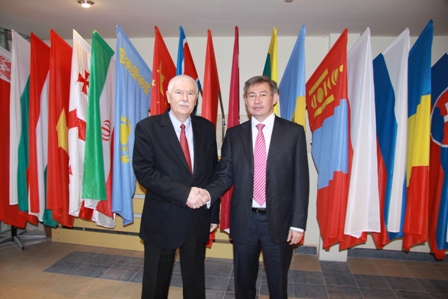
13 February 2013 Ambassador Extraordinary and Plenipotentiary of the Republic of Kazakhstan to the Republic of Poland, Mr Erik Myltykbaevich Utembaev paid a working visit to the OSJD Committee. During the visit he was informed of the activities of the OSJD and the significant role played by Kazakhstan in the sustainable development of the international rail traffic between Asia and Europe.
In the period from 14 till 18 January 2013 Sankt Petersburg hosts a Coordination meeting for International Passenger Traffic FTE A (Forum Train Europe), which, inter alia, is attended by the representatives of OSJD member and observer railways, OSJD Committee, UIC. Such a meeting of FTE, organized by FPC JSC, is carried out for the first time in Russia.
Pilotlauf der Containerzüge nach dem vereinheitlichten Frachtbrief CIM/SMGS
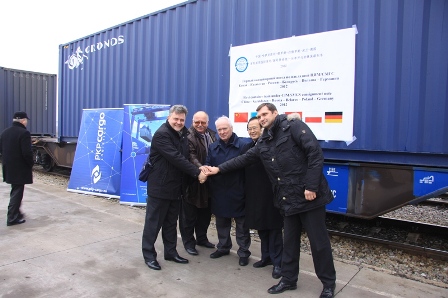
31. Oktober 2012 ist ein bedeutendes Ereignis in der Organisation der Containerzüge im Verkehr Asien – Europa: an diesem Tag hat aus der Stadt Chóngqìng, die sich im zentralen Teil Chinas befindet, nach Duisburg (Deutschland) der Containerzug unter Ausnutzung des vereinheitlichten Frachtbriefes CIM/SMGS zum ersten Mal abgesandt. Der Zug besteht aus 42 Container-Wagen mit 40-Fuss Container mit der folgenden Ladung: 41 - mit den Elektrowaren und der Bürotechnik, und 1 - mit der Kleidung.
Gleich nach dem ersten Zug nach dieser Reiseroute waren am 2. November des laufenden Jahres noch 4 Containerzüge mit der Computertechnik an die Adresse vom Empfänger “ Hewlett Packard Centre de Competence France und Competition Team Ireland Limited“ abgesandt. Insgesamt sind im November 200 Container-Wagen abgesandt.
Die Organisatoren des OSShD-Pilotprojektes für Demonstrationslauf der Containerzüge von Chóngqìng nach Duisburg sind die Chinesischen Eisenbahnen (KZD), Nationale Gesellschaft „Kasachstan temir Zholy“ AG (KZH), „Russische Eisenbahnen“ AG (führender Vollzieher des Pilotprojektes), die Weißrussische Eisenbahn (BC), „Polnische Staatsbahnen – Cargo“ (PKP Cargo AG) und Deutsche Bahn AG (DB Schenker Rail).
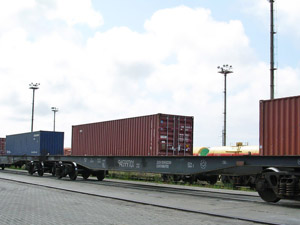
Die Anwendung zum ersten Mal auf der Reiseroute aus China nach Deutschland des vereinheitlichten Frachtbriefes CIM/SMGS wird zur bedeutenden Vereinfachung der Prozeduren bei dem Überschritt der Grenzen beitragen, die zusätzliche Neuanfertigung der Transportdokumente ausgeschlossen, was zur ziemlich deutlichen Kürzung der Reisezeit bringen soll und die Konkurrenzfähigkeit der Gütertransporte im Transit von Asien nach Europa über die OSShD-Eisenbahnen erhöhen.
Weitere Entwicklung der Güterbeförderung
unter Verwendung des Einheitsfrachtbriefes CIM/SMGS
In der Zeit vom 2. bis 4. Oktober 2012 stand in der Stadt Zamosc (Polen) eine Beratung der Experten von OSJD-Kommission für Lastentransporte mit dem Thema „Durchführung von Maßnahmen zur Organisierung von Güterbeförderung unter Verwendung des Einheitsfrachtbriefes CIM/SMGS“ statt, an der Vertreter von Eisenbahnen Ungarns, Kasachstans, Chinas, Lettlands, Litauens, Moldawiens, Polens (PKP Cargo AG, PKP LHS GmbH), Russlands, Slowakei, der Ukraine, Tschechiens, Deutschlands (DB Schenker Rail), Rail Cargo Hungaria GAG und PLASKE AG – von angegliederten Unternehmen der OSJD, und auch von CCTT und OSJD-Komitee teilnahmen.
Die Beratung wurde vom Sekretär des OSJD-Komitees Kalman Somodi eröffnet, der sich mit einer Grußansprache an die Teilnehmer wendete und die Wichtigkeit der durchgeführten Arbeiten zur Organisierung der Pilotfahrt eines Containerzuges aus China nach Deutschland unter Verwendung des Einheitsfrachtbriefes CIM/SMGS betonte und auch über die Planung von künftigen Containertransporten in der Richtung „Asiatische Länder – europäische Länder“ berichtete.
Im Namen des Organisators wurde die Beratung vom Direktor für Kommerz- und Betriebsangelegenheiten der PKP LHS GmbH („Breitspurige metallurgische Eisenbahn“) Miroslav Smultschinski begrüßt.
Im Rahmen der Tagesordnung wurden folgende Fragen besprochen:
- Organisierung der Pilotfahrt eines Containerzuges aus China nach Deutschland;
- Vorbereitung durch die Beratungsteilnehmer weiterer Fahrten von Containerzügen unter Verwendung des Einheitsfrachtbriefes CIM/SMGS;
- Sachstand zur Aktualisierung des Anhangs 22 zum SMGS (Anleitung zum Frachtbrief CIM/SMGS) und andere Fragen.
Ablauf der Vorbereitung der Pilotfahrt eines Containerzuges Urumqi – Berlin.
Während der Besprechung hat der Hauptausführende dieses Projektes – RZD AG – die Beratungsteilnehmer von den Ergebnissen der durchgeführten Maßnahmen zur Pilotfahrt eines Containerzuges auf der Strecke Urumchi (China) – Berlin (Deutschland) unter Teilnahme von Chinesischen Eisenbahnen, Kasachischen Bahn, RZD AG, Weißrussischen Bahn, PKP Cargo AG und DB Schenker Rail, sowie von Aussichten der Organisierung des Containerzugbetriebs auf der funktionierenden Strecke Chongqing – Duisburg unterrichtet.
Der Hauptausführende hat zusammen mit beteiligten Eisenbahnverwaltungen – Chinesische Bahn, Kasachische Bahn, Weißrussische Bahn, AG PKP Cargo und DB Schenker Rail für die Organisierung des Pilottransportes eine große Arbeit in vielen Richtungen geleistet, und zwar:
- Sicherung von Frachtbasis, Wagen und Containern für die Pilotfahrt des Containerzuges;
- Bestimmung der technischen Betriebsparametern für die Pilotfahrt des Containerzuges;
- Verwendung des Einheitsfrachtbriefes CIM/SMGS;
- Abstimmung der Route der Pilotfahrt des Containerzuges;
- Abstimmung des Fahrplans des Vorführungscontainerzuges;
- Abstimmung der Tarifbedingungen für die Pilotfahrt des Containerzuges;
- Teilnahme von Operatoren/Spediteuren;
- Berufung der Koordinatoren von den Teilnehmern des Pilotfahrtprojektes.
Es wurde erwähnt, dass die Pilotfahrt auf der Strecke Urumchi – Berlin unter realen Marktbedingungen geplant war, aber der Kunde hat doch die Entscheidung getroffen, die Fracht mit einem alternativen Verkehrsträger zu befördern.
Die Beratungsteilnehmer wurden durch den Hauptausführenden von der Arbeit informiert, die für die Pilotfahrt des Containerzuges auf der Strecke Chongqing – Duisburg durchgeführt wurde, von der Gründung im April 2012 in der Stadt Chongqing (Volksrepublik China) eines Gemischtunternehmens „YuXinOu“ (Chongqing) Logistics Co., Ltd., dem Transportholding der Stadt Chongqing, Chinesische Eisenbahngesellschaft „CRIMT“, „RZD Logistika“ (Tochtergesellschaft der RZD AG), DB Schenker China und Kastransservis AG angehören. Kerngeschäft des Gemischtunternehmens ist die Organisierung der regelmäßigen Frachtcontainertransporte per Eisenbahn auf der Strecke Chongqing – Duisburg, sowie die Erbringung von Zoll-, Informations- und Konsultationsdienstleistungen, die mit der Sicherung von internationalen Containertransporten verbunden sind.
Ein Vertreter der Chinesischen Esenbahnen hat die Beratungsteilnehmer über das Folgende informiert: die Leitung des Ministeriums für Eisenbahnwesen der Volksrepublik China hat den Vorschlag über die Verwendung des Einheitsfrachtbriefes CIM/SMGS untersucht, abgestimmt und unterstützt. Diese Ansicht wurde mehrmals geäußert. Vor kurzer Zeit hat der Minister für Eisenbahnwesen der Volksrepublik China Shen Guanzu in seinem Rückschreiben an OSJD-Ausschuss nochmals erwähnt, dass es bei der Chinesischen Bahn zurzeit keine Hindernisse für die Verwendung des Einheitsfrachtbriefes CIM/SMGS gibt. Dabei hat sich die Chinesische Bahn schon an die entsprechenden Organisatoren von Containertransporten mit einer Bitte gewendet, die Idee von Verwendung des Einheitsfrachtbriefes CIM/SMGS pragmatisch und aktiv zu verwirklichen. Die Verantwortung für diese Arbeit trägt zurzeit unmittelbar die Chinesische Korporation der Eisenbahncontainertransporte (CRCT). Am Anfang des laufenden Jahres hat diese Gesellschaft bereits die Test-Verwendung des Einheitsfrachtbriefes CIM/SMGS an den Grenzbahnhöfen Mandschurei, Erlian und Alashanko angefangen. Neue Frachtbriefe CIM/SMGS wurden vorbereitet und gedruckt. Im Februar 2012 hat die Korporation CRCT für die Frachtabsender eine Beratung organisiert, in der die große Bedeutung der Verwendung des Einheitsfrachtbriefes CIM/SMGS betont wurde, und auch die Regeln dessen Ausfüllens demonstriert. Die Reaktion der Frachtabsender war positiv.
Der Vertreter der Chinesischen Bahn hat den Beratungsteilnehmern über die Maßnahmen berichtet, die das Ministerium für Eisenbahnwesen der Volksrepublik China durchführt, um die Pilotfahrt eines Containerzuges auf der Strecke Chongqing – Duisburg unter Verwendung des Einheitsfrachtbriefes CIM/SMGS zu organisieren.
Ein Vertreter von DB Schenker Rail hat die Bereitschaft bestätigt, im Oktober 2012 den Pilotcontainerzug auf der Strecke Chongqing – Duisburg unter Verwendung des Einheitsfrachtbriefes CIM/SMGS in Zusammenarbeit mit dem Gemischtunternehmen „YuXinOu“ (Chongqing) Logistics Co., Ltd., das der Operator und Zahler des Transportes ist, zu versenden. Er hat auch eine Reihe von organisatorischen Fragen gestellt, die sich auf das Ausfüllen des Einheitsfrachtbriefes CIM/SMGS, den Fahrplan des Containerzuges, die Bestimmung von Koordinatoren von jeder Eisenbahngesellschaft, Gewährleistung von Informationsbegleitung auf der ganzen Strecke bezogen, und hat die Notwendigkeit betont, die gestellten Fragen noch vor Beginn der Pilotfahrt des Containerzuges unter allen Projektteilnehmern zu regeln.
Die Vertreter der beteiligten Eisenbahnen haben die Bereitschaft bestätigt, die Pilotfahrt des Containerzuges auf der Strecke Chongqing – Duisburg unter Verwendung des Einheitsfrachtbriefes CIM/SMGS auf ihren Teilstrecken ohne irgendwelchen Komplikationen und mit Unterstützung des zügigen Ablaufs der Fahrt durchzuführen, darunter auch die operative Abstimmung des Fahrplans.
In Übereinstimmung mit dem Entschluss der Beratung der Experten von OSJD-Kommission für Güterverkehr zu behandelndem Thema, die am 22.-23. Februar 2012 in Peking stattfand, haben die Vertreter von LDZ, LG und Ukrainischer Bahn die Informationen über aktuelle Tarifbedingungen und Präzisierungen zu den Routen gegeben.
Vorbereitung der nachfolgenden Containerzugfahrten unter Verwendung des Einheitsfrachtbriefes CIM/SMGS.
Die Vertreter von GAG „MAV“ und GAG „Rail Cargo Hungaria“ haben über die am 27. August 2012 in Moskau durchgeführten Verhandlungen mit dem Hauptausführenden - RZD AG – berichtet, deren Thema die Organisierung eines Containerzuges auf der Route Urumchi – Alashankou / Dostyk – Iletzk I / Kanisaj – Susemka / Zernovo – Tschop/Zahony – weiter in der Richtung Süd- und Süd-Westeuropa unter Verwendung des Einheitsfrachtbriefes CIM/SMGS war. Es wurde festgestellt, dass die Organisierung der Güterbeförderung auf dieser Route Ende 1. Quartal 2013 durchgeführt werden kann.
In seinem Vortrag zu dieser Frage hat der Präsident von AO „PLASKE“ (angegliedertes Unternehmen von OSJD) Oleg Platonov den Beratungsteilnehmern vorgeschlagen, die behandelnden Themen als eine Marketingentscheidung anzusehen. Aufgrund dessen hat er bemerkt, dass es notwendig wäre, das Material für die Entwicklung im Rahmen von OSJD eines „Produktes“ zu vorbereiten, welches in vollem Umfang wirtschaftliche, finanzielle und technologische Aspekte wiederspiegelt, die mit der Organisierung von Containerzügen verbunden sind, und die Kriterien für die Beförderungsteilnehmer auszuarbeiten, darunter auch unter Verwendung des Einheitsfrachtbriefes CIM/SMGS.
Die Beratungsteilnehmer haben abgestimmt, diese Aufgabe (Ausarbeitung der Kriterien und Parametern für die Organisierung der Güterbeförderung mit Containerganzzügen) im 2013 zur Erörterung im Rahmen des gegebenen Themas in die Tagesordnung einzuschließen.
Der Vertreter der Moldawischen Bahn hat den Teilnehmern der Besprechung dieses Themas vorgeschlagen, die Möglichkeit zu betrachten, die Güterbeförderung mit den Containerzügen durchzuführen, die im Transit auf dem moldawischen Gebiet fahren, unter Verwendung des Einheitsfrachtbriefes CIM/SMGS auf den Routen:
– Urumchi – Alashankou / Dostyk – Iletzk I / Kanisaj – Susemka / Zernovo – Kasatin – Shmerinka – Mogilev Podolski / Veltschinez – Ungheni / Cristesti Jijia – Giurgiu / Ruse – weiter nach Bulgarien, Griechenland, Türkei;
– Urumchi – Alashanko / Dostyk – Iletzk I / Kanisaj – Susemka / Zernovo – Kutschurgan / Novosavitskaja – Reni – Giurgiulesti / Galaz – Giurgiu / Ruse – weiter nach Bulgarien, Griechenland, Türkei.
Der Vertreter von ZU hat über die Veränderung der Route berichtet, die durch die Ukraine läuft: Urumchi – Alashanko / Dostyk – Iletzk I / Kanisaj – Susemka / Zernovo – Tschop / Slowakei oder Ungarn – europäische Länder.
Die Teilnehmer haben ihre Interessiertheit an die Durchführung der Güterbeförderung mit den Containerzügen auf den folgenden Routen bestätigt:
– Urumchi – Alashanko / Dostyk – Kartaly-1 – Krasnoje – Brest – Terespol – Kunowice – Berlin mit Beteiligung von Chinesischer Eisenbahnen, Kasachischer Bahn, RZD AG, Weißrussischer Bahn, PKP Cargo AG, DB AG;
– Urumchi – Alashanko / Dostyk – Kanisaj – Krasnoje – Brest – Terespol – Kunowice – Berlin mit Beteiligung von Chinesischer Eisenbahnen, Kasachischer Bahn, RZD AG, Weißrussischer Bahn, PKP Cargo AG, DB AG;
– Urumchi – Alashanko / Dostyk – Iletzk I / Kanisaj – Susemka / Zernovo – Tschop / Slovakei oder Ungarn – europäische Länder mit Beteiligung von Chinesischer Eisenbahnen, Kasachischer Bahn, RZD AG, Ukrainischer Bahn, ZSSK Cargo oder GAG MAV, GAG Rail Cargo Hungaria;
– Urumchi – Alashanko / Dostyk – Semiglawy Mar / Ozinki – Posin / Zilupe – Eglaine / Rokiskis – Fähre Draugyste – Sassnitz-Mukran – Berlin mit Beteiligung von Chinesischer Eisenbahnen, Kasachischer Bahn, RZD AG, Weißrussischer Bahn, LDZ, LG und DB AG;
– Urumchi – Alashanko / Dostyk – Kartaly-1 – Krasnoje / Ossinovka – Gudogaj / Kena – Fähre Draugyste – Sassnitz-Mukran – Berlin mit Beteiligung von Chinesischer Eisenbahnen, Kasachischer Bahn, RZD AG, Weißrussischer Bahn, LG und DB AG;
– Urumchi – Alashanko / Dostyk – Semiglawy Mar / Ozinki – Posin / Zilupe – Eglaine / Rokiskis – Mockava / Trakiszki – Warschau – Kunowice / Frankfurt an der Oder – Berlin mit Beteiligung von Chinesischer Bahn, Kasachischer Bahn, RZD AG, Weißrussischer Bahn, LDZ, LG, PKP Cargo AG und DB AG;
– Urumchi – Alashanko / Dostyk – Kartaly-1 / Tobol – Krasnoje / Ossinovka – Gudogaj / Kena – Sestokai– Mockava / Trakiszki – Warschau – Kunowice / Frankfurt an der Oder – Berlin mit Beteiligung von Chinesischer Eisenbahnen, Kasachischer Bahn, RZD AG, Weißrussischer Bahn, LG, PKP Cargo AG und DB AG;
– China – Kasachstan – Ust-Luga (Russland) – Sassnitz-Mukran (Deutschland) – europäische Länder.
Ablauf der Aktualisierung des Anhangs 22 zum SMGS
Es wurde ein Bericht über die durchgeführten Maßnahmen zur Aktualisierung und Verbesserung des Anhangs 22 zum SMGS (Anleitung zum Frachtbrief CIM/SMGS) entgegengenommen. Es wurde erwähnt, dass der Anhang 3 der Anleitung zum Frachtbrief CIM/SMGS in dem Teil aktualisiert ist, wo es sich über die Einführung der Codes von Weiterabfertigungsbahnöfen handelt, und dass auch die Einführung in die Anleitung zum Frachtbrief CIM/SMGS eines neuen Anhangs 7.5 bezüglich des Punktes 20 „Routen (Gruppen) von Wagen, Containern, die mit einem einzigen Frachtbrief CIM/SMGS aufgeliefert werden“ geplant wird. Diese Ergänzung wurde von ZSSK Cargo wegen den zahlreichen Wagen- und Containerabläufen an der slowakisch-ukrainischen Grenze vorgeschlagen, und deren Vereinbarung wurde für November des laufenden Jahres in der Beratung der Steuergruppe angesetzt.
Der Vertreter von CD Cargo hat über die Anfrage an NK „KTZh“ AG hinsichtlich der Güterbeförderung in Containern unter Verwendung des Einheitsfrachtbriefes CIM/SMGS auf der Route Prag (Tschechien) – Bhf. Zachita (Kasachstan) durch die Grenzbahnhöfe Kartaly, Aksu berichtet.
Es wurde erwähnt, dass von kasachischer Seite die Eintragung von Ergänzungen in den Anhang 1 der Anleitung zum Frachtbrief CIM/SMGS (Anhang 22 zum SMGS) erwartet wird, was zur Vergrößerung der Zahl von Routen der kasachischen Bahn führen wird, die den Einheitsfrachtbrief CIM/SMGS benutzen.
Elektronische Datenverarbeitung und „Elektronischer Zug“
Der Vertreter von CCTT hat über das Pilotprojekt von CCTT berichtet und bemerkt, dass das Pilotprojekt „Elektronischer Zug“ zu einem real funktionierenden experimentellen konkurrenzfähigen internationalen logistischen Produkt werden soll in Form eines regelmäßig auf der transsibirischen Strecke verkehrenden experimentellen Güterzuges, in dem moderne Informationstechnologien mit elektronischen Datenverarbeitung eingesetzt werden.
Dafür wurde durch CCTT-Arbeitsgruppe für die Entwicklung von Informationstechnologien folgende Arbeit geleistet:
- Konzept des Pilotprojektes „Elektronischer Zug“ erstellt;
- Basisobjekt für die Einführung des Projektes bestimmt;
- Projekt einer durchgehenden Informationstechnologie für die
Organisierung der Güterbeförderung im Pilotzug ausgearbeitet;
- Projekt eines Abkommens über den elektronischen Daten- und Dokumentenaustausch unter allen Beteiligten an dem Güterbeförderungsprozess ausgearbeitet;
- Verkehr des experimentellen Zuges „Ostwind“ organisiert, der ein gemeinsames Produkt von Deutscher, Polnischer, Weißrussischer, Russischer und Kasachischer Bahn, sowie von dem internationalen Holding „TransInvest“ ist. Der Verkehr ist unter Berücksichtigung dessen Versorgung mit
- durchgehender Informationstechnologie;
- rollendem Material;
- Infrastruktur-Ressourcen, einschließlich des festen Einzelfahrplans organisiert.
In die logistische Kette des Pilotprojekts sind nicht nur IT-Systeme der Eisenbahn, sondern auch die des Pilotzuges und des Zollamtes eingeschlossen. Das hat erlaubt, die manuelle Eingabe bei der Vorbereitung der Mitteilungen am Zugbildungsbahnhof (Großbeeren, Deutschland) und am Bahnhof, wo die Frachtbriefe CIM/SMGS neuabgefertigt werden (Malaszewicze), auszuschließen.
Wegen den wesentlichen Unterschieden auf den Rechtsfeldern, die den Bereich der elektronischen Datenverarbeitung regeln, von Ländern, deren Eisenbahnen sich an der Frachtbeförderung mit dem Containerzug „Ostwind“ beteiligen, ist die Ausarbeitung und Unterschreibung eines einheitlichen Vertrages über Übergang auf die elektronischen Dokumenten, mit welchen die Güter im Containerzug „Ostwind“ befördert werden, von allen Ländern unmöglich ist.
Darum wurde die Entscheidung über die Elektronisierung der Dokumenten durch den schrittweisen Übergang auf den elektronischen Dokumentenaustausch getroffen. Dabei werden bilaterale Verträge zwischen den Verwaltungen von Nachbareisenbahnen für die Elektronisierung des Dokumentenaustausches zwischen beiden Eisenbahnverwaltungen abgeschlossen.
Für die Optimierung der Technologie der Verwendung von elektronischen Frachtbeförderungsdokumenten im internationalen Verkehr von RZD AG wurden entsprechende bilaterale Abkommen über die Bewegung von privaten Leerwagen mit Eisenbahnverwaltungen von Finnland und Lettland abgeschlossen, aufgrund deren der elektronische Dokumentenaustausch bei der Beförderung von privaten Leerwagen (aus Finnland nach Russland und zurück – seit 2011, aus Lettland nach Russland – seit April 2012) geführt wird. In greifbarer Zukunft steht der Beginn der Beförderung von privaten Leerwagen aus Litauen nach Russland.
Die CCTT-Arbeitsgruppe nimmt Rücksicht auf die Kompliziertheit dieses Problems, deswegen arbeitet sie mit OSJD im Rahmen des Thema „Die Ausarbeitung von Empfehlungen für die Verwendung von elektronischer Signatur bei der Informationsbegleitung der Güterbeförderung im internationalen Eisenbahnverkehr“ zusammen, wo Weißrussische Bahn und RZD AG zu den führenden Unternehmen gehören. Für die praktischen experimentellen Entscheidungen wäre es notwendig, eine Ansprache von einer der führenden Bahnen an die OSJD (an die Mitglieder von SMGS) vorzubereiten, mit den Vorschlägen über die Eintragung von Ergänzungen in SMGS, welche für die Beteiligten am Beförderungsprozess eine Möglichkeit des Austausches von elektronischen juristisch relevanten Transport- und Begleitdokumenten sichern, die in unterschiedlichen rechtlichen Zonen angefertigt sind. Als eine Vorbereitungsmaßnahme für die Eintragung solcher Ergänzungen schlägt die CCTT-Arbeitsgruppe vor, das gültige Abkommen über den elektronischen Datenaustausch zwischen Weißrussischer Eisenbahn und AG PKP, zwischen Weißrussischer Bahn und RZD AG, und auch RZD AG und Chinesischer Bahn mit den Abschnitten über den Austausch von elektronischen (juristisch relevanten) Unterlagen zu ergänzen und sie mit OSJD zu vereinbaren.
Danach wird es möglich, sich auf diese Ergänzungen stützend, die Versuchsprozedur des Austausches von Transport- und Begleitdokumenten des Pilotzuges „Ostwind“ zu beginnen.
Die Bestätigung der Legitimität (der juristischen Relevanz) von elektronischen Signaturen der Parteien wird unter Verwendung der Technologie von paarigen „vertrauten Drittparteien“ geplant, die die Integrität des Dokumentes und die Echtheit der elektronischen Signatur einer der Parteien nach der Anfrage von zweiter Partei überprüfen werden. Eine vertraute Drittpartei wird die Sicherheit der Prozedur der Überprüfung von elektronischer Signatur unter allen notwendigen Sicherheitsforderungen und unter Berücksichtigung von konkreten Besonderheiten der jeweiligen Rechtszone ermöglichen.
Parallel führt RZD AG Verhandlungen mit der Eisenbahnverwaltung von Kasachstan über den Übergang auf den elektronischen Dokumentenaustausch zwischen den Parteien.
In der Zukunft ist der Übergang auf den vollen elektronischen Dokumentenaustausch zwischen den Ländern geplant, sowohl bei der Bewegung privaten Leerwagen, als auch bei der Frachtbeförderung unter Verwendung von elektronischen Signaturen und vertrauten Drittparteien für die Bestätigung der juristischen Relevanz von elektronischen Signaturen der Parteien.
Bau von neuen Eisenbahnstrecken
Der Vertreter der Chinesischen Bahn hat berichtet, dass im Jahre 2011 der Bau vom kasachischen Teil der neuen Eisenbahnstrecke Usen – Gorgan beendet wurde, deren Ziel die Entwicklung von Export- und Transitfrachtenströmen auf die Märkte von Iran und Golfstaaten ist. Diese Eisenbahn wird den Zugang von europäischen Ländern zu den Häfen im Persischen Golf, die Bahnhöfe entlang dieser Strecke werden zu internationalen Transportknoten. Diese Route ist drei Mal kürzer, als die Route zum Suez-Kanal. In Übereinstimmung mit der im Juni 2012 unterzeichneten Vereinbarung ist die Beendigung des Baus vom iranischen Teil am Ende des laufenden Jahres geplant.
Außerdem ist der Bau von Strecke Zhetygen – Korgas beendet, die der Verkürzung von Gütertransportwegen aus China in die Länder von Zentralasien sowie in der Richtung des internationalen Transportkorridors TRACECA dienen wird.
Es wurde mit dem Bau von Eisenbahnstrecke Zheskasgan – Saksaulskaja – Schalkar – Beyneu begonnen, die die anziehende Bedingungen für den Warenausfuhr aus China in die Häfen am Schwarzen Meer und im Baltikum schaffen wird, die den Zugang zu den EU-Märkten haben.
Für die Lösung der Aufgabe zur Schaffung eines komplexen Transport- und Logistiksystems, zur weiteren Entwicklung des Transitpotentials von Kasachstan und Bildung aus Kasachstan einer Handels-, Logistik- und Geschäftsdrehscheibe der Region wird „NK „KTZh“ AG als logistischer Operator in der Republik Kasachstan bestimmt. Orientiert an der Vereinigung von Transportzweigen und begleitenden Dienstleistungen in eine Kette von Businessprozessen, wird auf der Grundlage von NK „KTZh“ AG „Nationale Transport - und Logistikgesellschaft“ gegründet, die zu einem komplexen Einheitszentrum für die Erbringung von Transportdienstleistungen auf allen Verkehrsträgern wird.
Erleichterter Grenzübertritt im internationalen Eisenbahn-Personen- und Güterverkehr
In der Zeit vom 26. – 27. Juni 2012 wurde in Sankt Petersburg (Russland) die VII. Zwischenbehördliche Tagung zu Fragen des erleichterten Grenzübertritts im internationalen Eisenbahn- Personen- und Güterverkehr durchgeführt. Eingeladen worden waren die Vertreter der Grenz-, Zoll-, Eisenbahn- und anderen interessierten Behörden und internationaler Organisationen der Republik Belarus, der Republik Kasachstan, der Volksrepublik China, der Republik Kirgisistan, der Republik Lettland, der Republik Litauen, der Republik Moldowa, der Republik Polen, der Russischen Föderation, Rumäniens, der Republik Usbekistan, der Republik Estland, Finnlands sowie der DB Schenker Rail (Beobachter der OSShD, Deutschland), der OTIF, der UIC, CIT, der Euroasiatischen Wirtschaftskommission, des Koordinierungsrates der Transsibirischen Transporte, der AO Plaske (angeschlossenes Unternehmen der OSShD, Ukraine), der OAO Transcontainer, der Vereinigung der Fahrzeugbetreiber Großbritanniens (ATOC) und des Komitees der OSShD.
Die Tagung wurde vom Ersten Stellvertreter des Leiters der Oktobereisenbahn der OAO RZD, Oleg Walinskij eröffnet, der die Tagungsteilnehmer begrüßte.
Den Tagungsteilnehmern wurden Grußbotschaften des Ministers für Transport der RF, Maxim Sokolow und der Direktorin des Departements Transport der UNECE, Ewa Molnar verlesen. Eine Grußansprache hielt Jean-Luc Dufournaud, Präsident des Internationalen Eisenbahntransportkomitees. Alle hochrangigen Führungskräfte hoben die Wichtigkeit und Notwendigkeit der Fortsetzung der Arbeiten zur Erleichterung der Grenzformalitäten hervor.
Im Verlaufe der Tagung behandelten die Teilnehmer:
- den Sachstand zur Frage des erleichterten Grenzübertritts im Eisenbahnverkehr der OSShD-Mitgliedsländer;
- analysierten sie die Vereinbarungen, Konventionen und Verträge, die im Rahmen der Regierungs- und Nichtregierungsorganisationen zu den Fragen des erleichterten Grenzübertritts ausgearbeitet wurden;
- erörterten sie Maßnahmen der Kooperation zur Anlage 9 „Erleichterte Grenzabfertigungsverfahren im internationalen Eisenbahntransporten“ zur Internationalen Konvention über die Abstimmung der Bedingungen für die Kontrolle der Güter an den Grenzen;
- erarbeiteten sie ein Gemeinsames Aktionsprogramm zum erleichterten Grenzübertritt im Eisenbahnverkehr sowie Empfehlungen, in denen die Maßnahmen zur verbesserten Grenzabfertigung im internationalen Eisenbahn-Personen- und Güterverkehr zusammengefasst wurden;
- behandelten sie die Anwendungspraxis des vereinheitlichten CIM/SMGS Frachtbriefs als effektivem Instrument für den erleichterten Grenzübertritt sowie der Informationstechnologien, die beim Grenzübertritt im Eisenbahnverkehr eingesetzt werden.
Die Tagungsteilnehmer verabredeten sich, die gesammelten Erfahrungen der internationalen Regierungs- und Nichtregierungsorganisationen zur Erleichterung der Grenzabfertigung zu nutzen und die neuen Richtungen der Zusammenarbeit der OSShD-Mitgliedsländer, der Zoll- und Grenzbehörden festzulegen. Umfassender und zielgerichteter sollen die Vereinbarungen, Verträge, Konventionen und Empfehlungen der UNECE, UNESCATO, der OSShD und des CIT auf diesem Gebiet genutzt werden.
Die Tagung würdigte die diesbezügliche Arbeit der OSShD. Wie in den Vorträgen der Vertreter des Komitees der OSShD festgestellt wurde, befasst sich die OSShD Kommission für Transportpolitik und Entwicklungsstrategie zielgerichtet mit diesem Thema, an dem sich die Fachleute der OSShD-Mitgliedsländer zu einer Vielzahl strategischer Ausrichtungen beteiligen, zu denen gehören:
- Verbesserung der internationalen transportrechtlichen Dokumente;
- Erleichterte Grenzabfertigung im Eisenbahnverkehr;
- Führen einer Statistik zu den Eisenbahngrenzübergängen;
- Ausarbeitung von technischen Pässen für 13 Eisenbahntransportkorridore, die vollständig abgeschlossen wurde, wie auch Erstellung einer neuen Struktur der komplexen Pläne zur Verbesserung der Transporte und Entwicklung der OSShD-Transportkorridore bis zum Jahre 2020;
- Aktive Zusammenarbeit mit der Europäischen Eisenbahnagentur (ERA) zur Gewährleistung der Interoperabilität der Eisenbahnsysteme 1435 und 1520 mm, im Rahmen der die Kontaktgruppe OSShD/UIC die Dokumente zur „Analyse der Parameter, die ausschlaggebend für die Aufrechterhaltung der technischen und betrieblichen Kompatibilität der Eisenbahnsysteme der Spurweite 1520 und 1435 mm an der Grenze EU – GUS sind: Nr. 1 Teilsystem: Gleisinfrastruktur und Gleiswirtschaft; Nr. 2 Energieversorgung; Nr. 3 Zugsteuerung, Zugsicherung und Signalgebung; Nr. 6 Triebfahrzeuge und Triebwagenzüge abschließend erarbeitet hat.
Im Zeitraum seit dem Jahr 2003 wurde die Ausarbeitung der Anlage 9 „Erleichterte Grenzabfertigungsverfahren im internationalen Eisenbahnverkehr“ zur Internationalen Konvention über die Abstimmung der Bedingungen der Kontrolle der Güter an den Grenzen von 1982 abgeschlossen (Inkraftsetzung ab 30. November 2011), die Erarbeitung der neuen und die Verbesserung der bestehenden Internationalen Konvention über die erleichterten Bedingungen der grenzüberschreitenden Eisenbahn-Personen- und Gepäckbeförderungen vom 10. Januar 1952 fortgesetzt sowie die UNO Konvention über den internationalen Zolltransit bei Eisenbahn-Gütertransporten unter Verwendung des SMGS-Frachtbriefes angenommen. Es entstand ein Gemeinsames Aktionsprogramm der Länder, Eisenbahnen, Behörden und internationalen Organisationen zur Erleichterung der Grenzübergangsbedingungen im Eisenbahnverkehr.
Im Rahmen der OSShD Kommission Güterverkehr wird intensiv an der Vervollkommnung der Tarife ЕТТ und MTT gearbeitet.
Im Rahmen der Zusammenarbeit mit der UIC werden in der Ständigen OSShD Arbeitsgruppe Kodierung und Informatik die Fragen der einheitlichen Kodierung und Nummerierung von Wagen (gemeinsames Projekt RICS), der Verwendung der elektronischen Unterschrift, der informationsseitigen Begleitung der elektronischen Daten des Gütertransports im internationalen Verkehr behandelt.
Gleichzeitig leistet die OSShD eine umfangreiche Arbeit im Hinblick auf die Aktualisierung der Grundsatzdokumente durch die Erstellung des Entwurfs der neuen Konvention „Über den direkten internationalen Verkehr“.
Die gemeinsame Arbeitsgruppe CIT-OSShD für transportrechtliche Harmonisierung hat 2006 das gemeinsame Projekt CIT-OSShD zur Schaffung eines vereinheitlichten CIM/SMGS Frachtbriefs erfolgreich realisiert, das gegenwärtig umfassende Anwendung und Entwicklung erfährt. Der Geltungsbereich dehnt sich immer mehr nach Osten in die Länder Asiens nach Kasachstan, der Mongolei und China aus; eine elektronische Version des Frachtbriefes wurde erstellt und aktualisiert. Die Arbeiten an der papierlosen Technologie für Gütertransporte dauern an.
Des weiteren arbeitet die Gemeinsame Gruppe OSShD/ESCATO UNO gegenwärtig an einem Projekt zur Entwicklung der Containertransporte in Ganzzügen im Verkehr Asien – Europa und auf Initiative der UN ECE an der Schaffung des „Einheitlichen Eisenbahntransportrechtes“.
Auf der Tagung wurde die Feststellung getroffen, dass zu den Faktoren, die eine raschere Grenzabfertigung der Güter und einen verringerten zeitlichen Aufwand für die Kontrollverfahren sowie die zeitliche Optimierung der Transitgüterabfertigung an den Übergangsstellen beeinflussen, die Einführung der Informationstechnologien und des elektronischen Dokumentenumlaufs, wie auch die erhöhte Qualität der Informationen beim Datenaustausch in elektronischer Form zwischen den Bahnverwaltungen zählen.
Die Tagung empfahl den Mitgliedsländern der OSShD, die Frage der Ausarbeitung einer neuen Konvention über die erleichterten Grenzabfertigungsverfahren im internationalen Eisenbahn-Personenverkehr auf der Grundlage des Projektes zu klären, das von der OSShD, OTIF, CIT, UIC und EU vorbereitet wurde.
In den von den Teilnehmern der Tagung nach der Bilanzierung der Arbeiten abgestimmten Schreiben an den Binnenverkehrsausschuss der UNECE und die OSShD und dem Aktionsprogramm zum erleichterten Grenzübertritt im Eisenbahnverkehr wurden die Bedingungen zur rascheren Abfertigung der internationalen Personen- und Güterzüge an den Staatsgrenzen umrissen, wie auch die Hauptrichtungen der gemeinsamen Arbeit der Zoll- und Grenzbehörden, der Eisenbahn- und Transportunternehmen der Mitgliedsländer der OSShD festgelegt.
Es wurde der Vorschlag unterbreitet, die nächste 8. Tagung in 2 Jahren durchzuführen.
